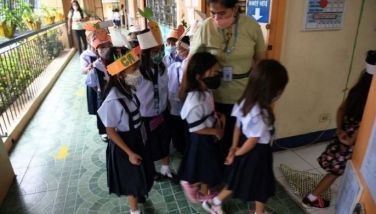Filipino wizards design computerized voting system
November 2, 2002 | 12:00am
 Computerized voting is an idea whose time has come in this Third World country.
Computerized voting is an idea whose time has come in this Third World country.
With the passage of the Absentee Voting Bill by both chambers of Congress, it won’t take long for an enabling law to be enacted. President Arroyo herself has assured the public that absentee voting will start in the 2004 elections.
The manual voting and counting system will then have to give way to a state-of-the-art system that will allow millions of overseas Filipinos to participate in the polls for the first time and give our local folk a taste of high tech.
Admittedly, the crossover to the electronic frontier will be difficult, especially with budgetary constraints and other logistic problems hanging over the head of the national government like the sword of Damocles.
However, a Filipino computer company says that it can be done, and yes, the Filipino can, at least technically.
In a hands-on demo to The STAR the other day, executives of Mega Data Corp., the systems integration arm of Mega Group of Computer Companies which is the prime computerization contractor of the National Bureau of Investigation (NBI), presented a homegrown online voting system which they hope to offer to the Commission on Elections (Comelec) for the 2004 polls.
The system, dubbed "Botong Pinoy," promises to eliminate most election-related fraud inherent in a manual voting and counting system such as multiple registration, "dagdag-bawas" (vote padding and shaving), ballot switching, ballot box snatching, and "ghost" precincts and barangays, among other anomalies.
The secret, according to Jose Avedillo, vice president and chief marketing officer of Mega Group, is the adoption of today’s cutting-edge technology and customizing its application to the Philippine election setting.
Botong Pinoy, Avedillo says, covers three aspects of the election process: registration of qualified voters, actual voting at the precinct level, and tabulation of results.
At the registration level, each of the country’s 200,000 voting precincts as well as the still undetermined number of precincts in other countries that will be opened for overseas Filipino voters, will be supplied with a set of computer terminals and printers.
In lieu of application forms, an applicant will be asked to type on the computer screen basic personal information such as name, address, birthday and gender. His photo will be taken by a mini camera installed on the PC itself and his left and right thumbs will be scanned for prints. These data will then be filed at the Comelec database.
Using the latest facial and fingerprint biometric technology, the system will not allow one person to register twice as computers in every precinct will be able to recognize the face and the fingerprint of all those who had already registered.
This eliminates the first Filipino electoral aberration - flying voters as well as "ghost" barangays and precincts.
In the actual voting, the same rule applies. Through the face and the fingerprint, the computer will be able to recognize the qualified voters in each precinct and ensure that they vote only once.
Voting itself will be a breeze as the computers will be programmed to talk (yes, you can listen to the instructions) either in English, Filipino, or any of the 20 most common local dialects in the country. The voter will be presented with the names, pictures and party affiliation of all the candidates in each position from the national down to the local level. To vote for a candidate, all one has to do is touch the screen over the face or name of the candidate and submit the vote.
Once the process is completed, a computer-generated ballot with a two-dimensional barcode will be printed. In the event of an election protest or whenever there is a need to recount the ballots, the 2D barcode in each ballot will only have to be scanned and all the votes in a particular precinct will be counted within minutes.
Avedillo said a fairly computer-literate person who has already his chosen candidates in mind before coming to the poll site will take less than three minutes to complete the entire voting process.
And even for those who have not even seen a computer in their entire life, the new voting system will not cause so much delay as properly trained election officers will be on hand to assist voters.
At the end of the election day, the system will automatically generate a precinct-level tally and transmit this to a secure Internet website for barangay, city/municipal, provincial/regional and national tabulation. As such, the results of the election will be known almost immediately, sans technical glitches and other electronic failures.
Joel Ong, Mega Group’s chief technical officer and SVP for systems research and development, says that the Botong Pinoy system, which will run on an ordinary Pentium-based PC, was put together by an all-Filipino technical and design team and is therefore proudly Filipino.
Asked on the company’s motivation to design an online voting system for the Philippines, even without being asked to, Avedillo readily answered: "For love of country."
"We have to show to the world that the we are capable of designing our own election software," he said. "And if successful we can even offer them to other countries."
Though Mega Group is offering the system free of charge to the Comelec, Avedillo said they will definitely join the bidding to supply the Comelec’s hardware, software and other technical needs for the elections.
BrandSpace Articles
<
>
- Latest
Latest
Latest
December 14, 2024 - 11:22am
By Karry Sison | December 14, 2024 - 11:22am
December 9, 2024 - 2:53pm
By Rupert Paul Manhit | December 9, 2024 - 2:53pm
December 8, 2024 - 9:00am
By Jing Castañeda | December 8, 2024 - 9:00am
November 30, 2024 - 5:19pm
By Joanna Perfecto | November 30, 2024 - 5:19pm
November 23, 2024 - 6:23pm
By Rupert Paul Manhit | November 23, 2024 - 6:23pm
November 23, 2024 - 1:52pm
By Edilberto de Jesus | November 23, 2024 - 1:52pm
Recommended
























